Implications of New Lease Standard on Financial Reporting
VerifiedAdded on 2023/06/03
|11
|2326
|369
AI Summary
This report analyzes the impact of the new lease standard on financial reporting of Australian companies. It includes a review of two journal articles, their similarities and differences, and implications for external reporting stakeholders.
Contribute Materials
Your contribution can guide someone’s learning journey. Share your
documents today.

Running head: LEASE
Lease
Name of the Student
Name of the University
Author Note
Lease
Name of the Student
Name of the University
Author Note
Secure Best Marks with AI Grader
Need help grading? Try our AI Grader for instant feedback on your assignments.
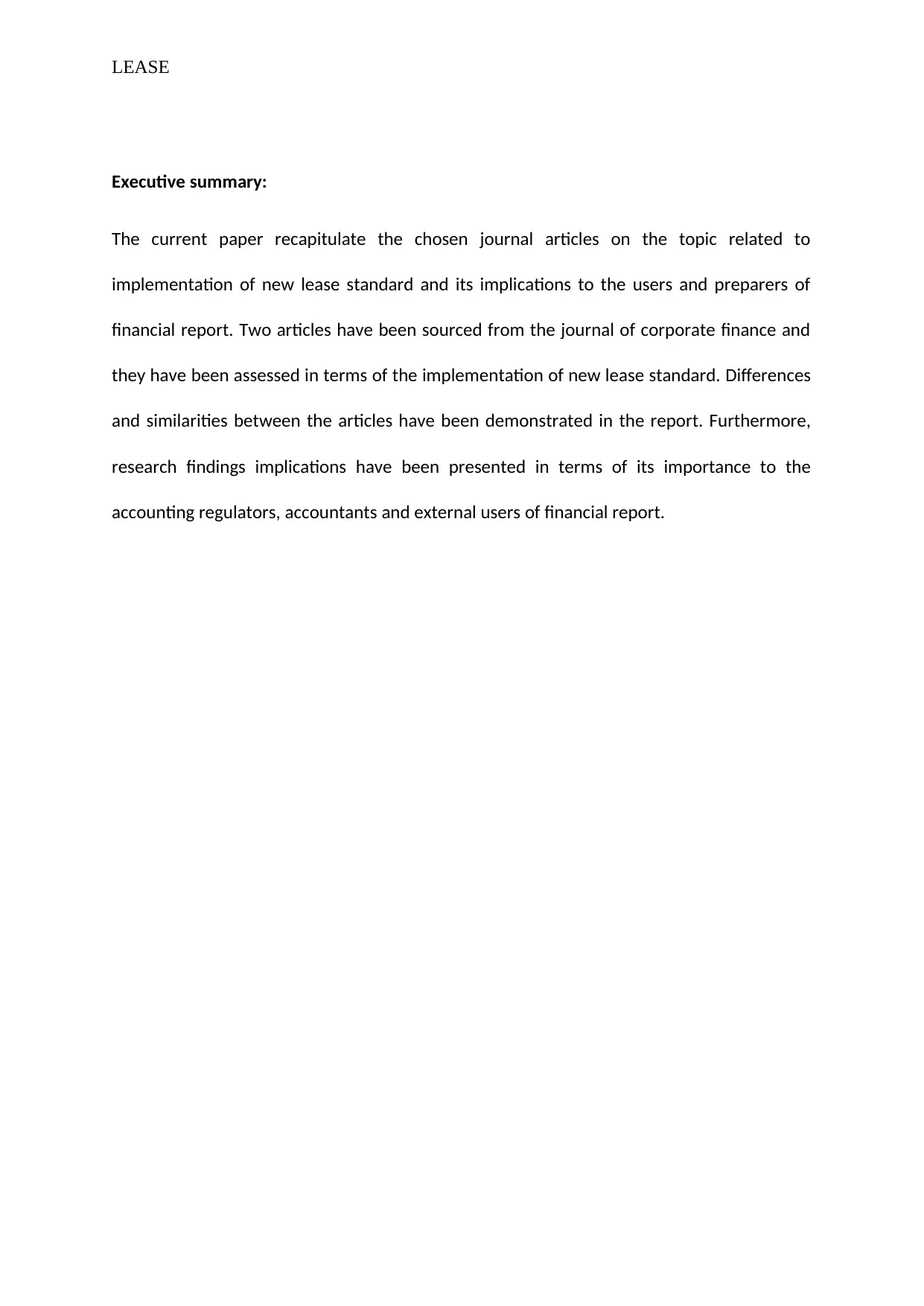
LEASE
Executive summary:
The current paper recapitulate the chosen journal articles on the topic related to
implementation of new lease standard and its implications to the users and preparers of
financial report. Two articles have been sourced from the journal of corporate finance and
they have been assessed in terms of the implementation of new lease standard. Differences
and similarities between the articles have been demonstrated in the report. Furthermore,
research findings implications have been presented in terms of its importance to the
accounting regulators, accountants and external users of financial report.
Executive summary:
The current paper recapitulate the chosen journal articles on the topic related to
implementation of new lease standard and its implications to the users and preparers of
financial report. Two articles have been sourced from the journal of corporate finance and
they have been assessed in terms of the implementation of new lease standard. Differences
and similarities between the articles have been demonstrated in the report. Furthermore,
research findings implications have been presented in terms of its importance to the
accounting regulators, accountants and external users of financial report.
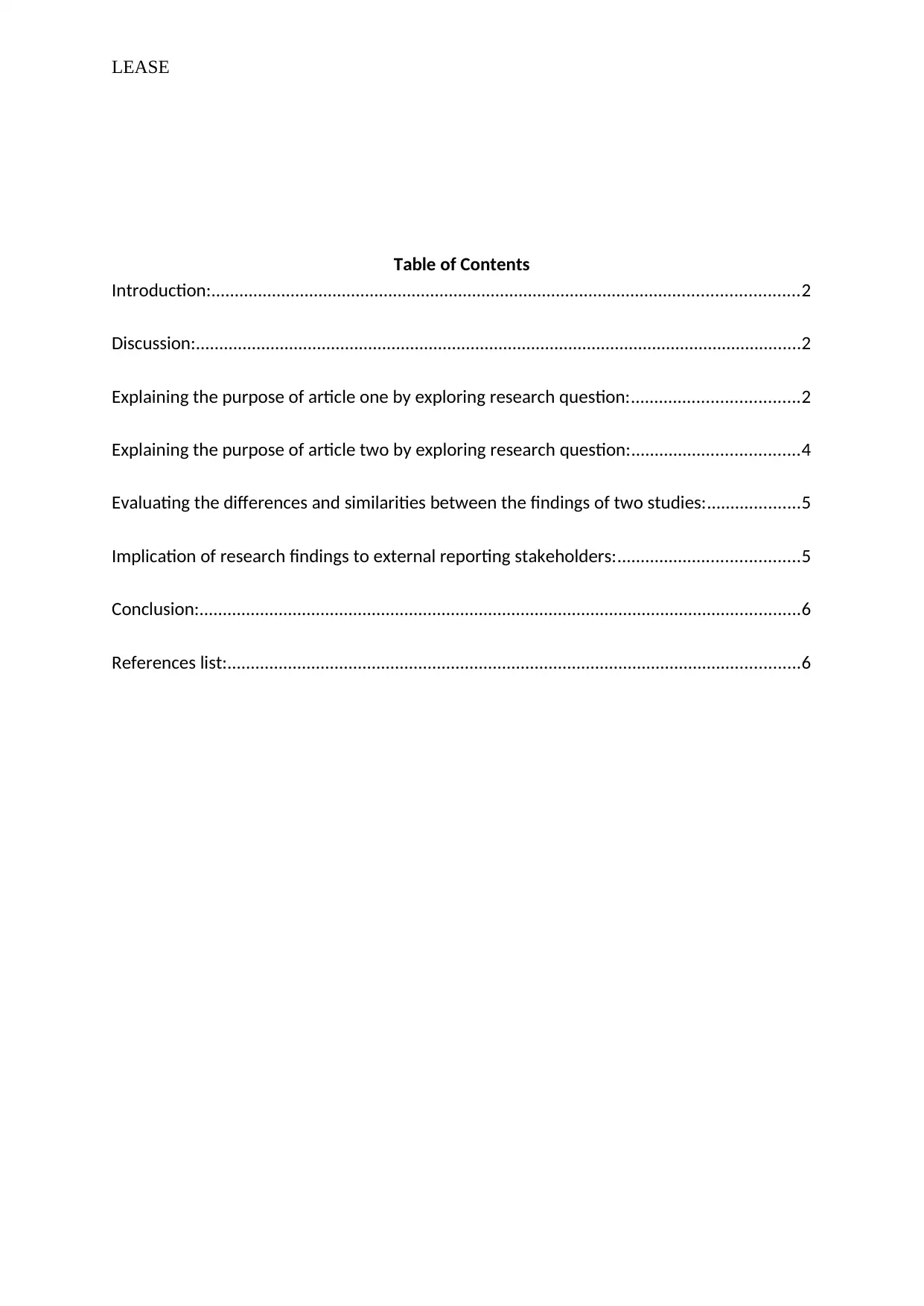
LEASE
Table of Contents
Introduction:..............................................................................................................................2
Discussion:..................................................................................................................................2
Explaining the purpose of article one by exploring research question:....................................2
Explaining the purpose of article two by exploring research question:....................................4
Evaluating the differences and similarities between the findings of two studies:....................5
Implication of research findings to external reporting stakeholders:.......................................5
Conclusion:.................................................................................................................................6
References list:...........................................................................................................................6
Table of Contents
Introduction:..............................................................................................................................2
Discussion:..................................................................................................................................2
Explaining the purpose of article one by exploring research question:....................................2
Explaining the purpose of article two by exploring research question:....................................4
Evaluating the differences and similarities between the findings of two studies:....................5
Implication of research findings to external reporting stakeholders:.......................................5
Conclusion:.................................................................................................................................6
References list:...........................................................................................................................6
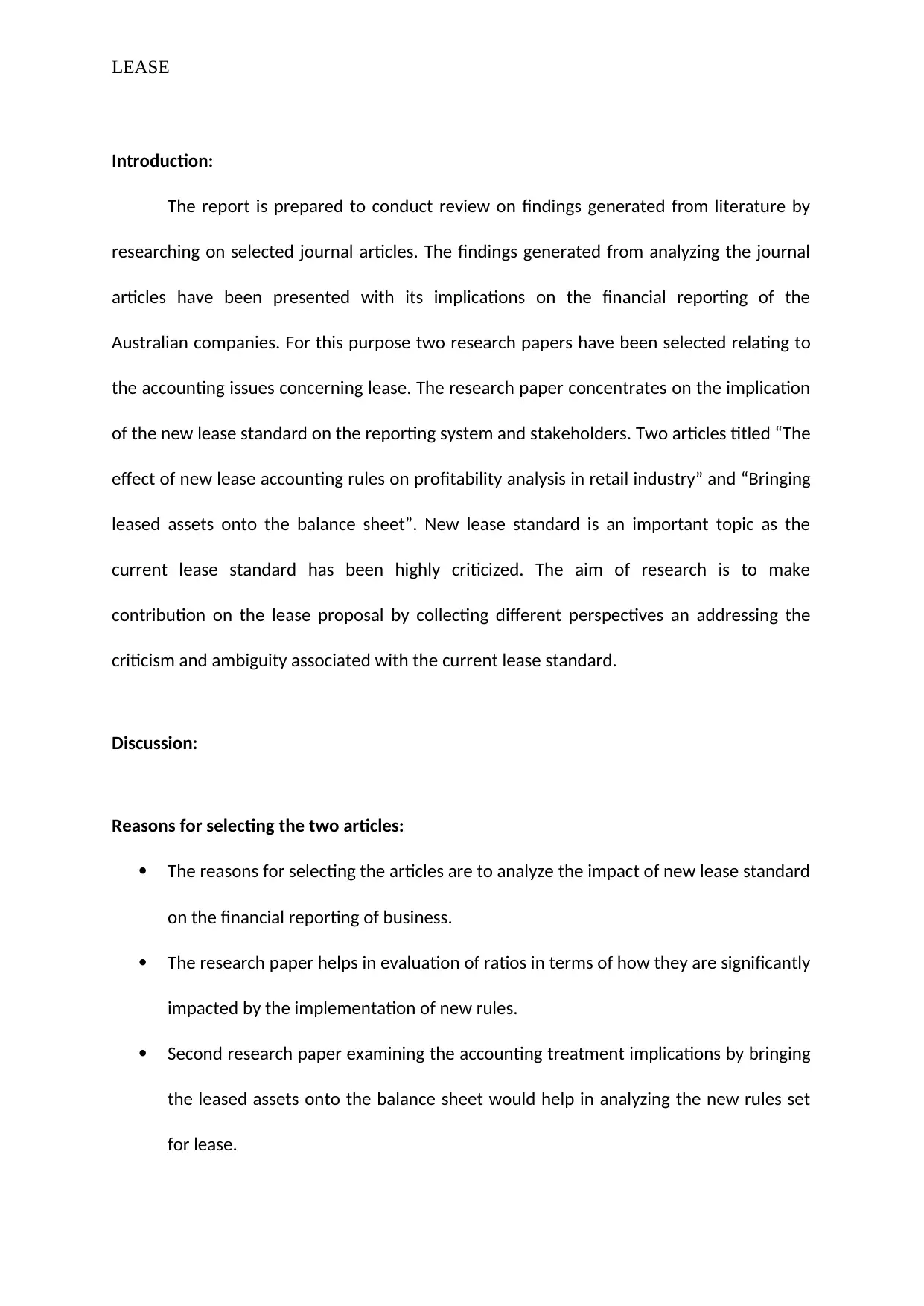
LEASE
Introduction:
The report is prepared to conduct review on findings generated from literature by
researching on selected journal articles. The findings generated from analyzing the journal
articles have been presented with its implications on the financial reporting of the
Australian companies. For this purpose two research papers have been selected relating to
the accounting issues concerning lease. The research paper concentrates on the implication
of the new lease standard on the reporting system and stakeholders. Two articles titled “The
effect of new lease accounting rules on profitability analysis in retail industry” and “Bringing
leased assets onto the balance sheet”. New lease standard is an important topic as the
current lease standard has been highly criticized. The aim of research is to make
contribution on the lease proposal by collecting different perspectives an addressing the
criticism and ambiguity associated with the current lease standard.
Discussion:
Reasons for selecting the two articles:
The reasons for selecting the articles are to analyze the impact of new lease standard
on the financial reporting of business.
The research paper helps in evaluation of ratios in terms of how they are significantly
impacted by the implementation of new rules.
Second research paper examining the accounting treatment implications by bringing
the leased assets onto the balance sheet would help in analyzing the new rules set
for lease.
Introduction:
The report is prepared to conduct review on findings generated from literature by
researching on selected journal articles. The findings generated from analyzing the journal
articles have been presented with its implications on the financial reporting of the
Australian companies. For this purpose two research papers have been selected relating to
the accounting issues concerning lease. The research paper concentrates on the implication
of the new lease standard on the reporting system and stakeholders. Two articles titled “The
effect of new lease accounting rules on profitability analysis in retail industry” and “Bringing
leased assets onto the balance sheet”. New lease standard is an important topic as the
current lease standard has been highly criticized. The aim of research is to make
contribution on the lease proposal by collecting different perspectives an addressing the
criticism and ambiguity associated with the current lease standard.
Discussion:
Reasons for selecting the two articles:
The reasons for selecting the articles are to analyze the impact of new lease standard
on the financial reporting of business.
The research paper helps in evaluation of ratios in terms of how they are significantly
impacted by the implementation of new rules.
Second research paper examining the accounting treatment implications by bringing
the leased assets onto the balance sheet would help in analyzing the new rules set
for lease.
Secure Best Marks with AI Grader
Need help grading? Try our AI Grader for instant feedback on your assignments.
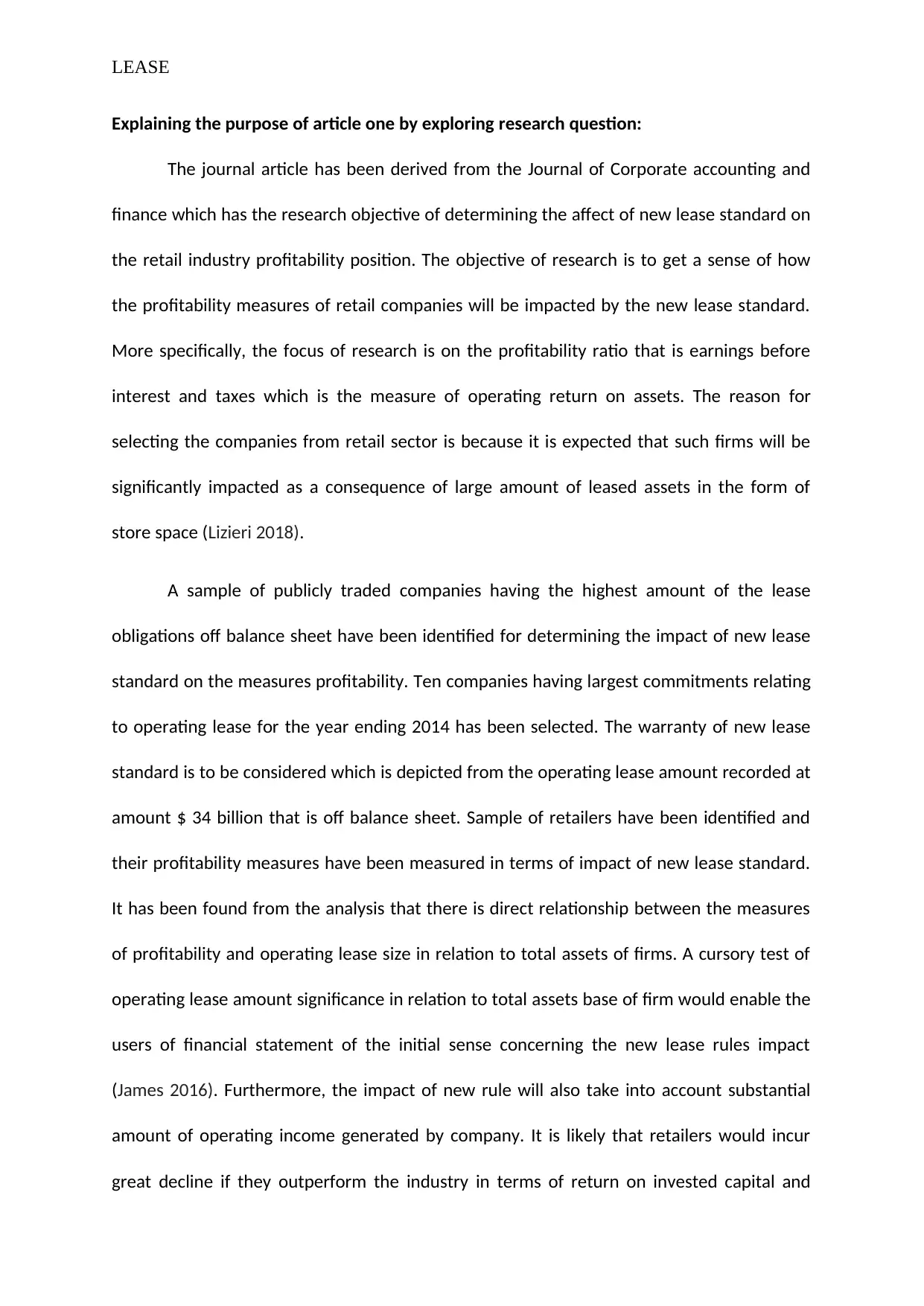
LEASE
Explaining the purpose of article one by exploring research question:
The journal article has been derived from the Journal of Corporate accounting and
finance which has the research objective of determining the affect of new lease standard on
the retail industry profitability position. The objective of research is to get a sense of how
the profitability measures of retail companies will be impacted by the new lease standard.
More specifically, the focus of research is on the profitability ratio that is earnings before
interest and taxes which is the measure of operating return on assets. The reason for
selecting the companies from retail sector is because it is expected that such firms will be
significantly impacted as a consequence of large amount of leased assets in the form of
store space (Lizieri 2018).
A sample of publicly traded companies having the highest amount of the lease
obligations off balance sheet have been identified for determining the impact of new lease
standard on the measures profitability. Ten companies having largest commitments relating
to operating lease for the year ending 2014 has been selected. The warranty of new lease
standard is to be considered which is depicted from the operating lease amount recorded at
amount $ 34 billion that is off balance sheet. Sample of retailers have been identified and
their profitability measures have been measured in terms of impact of new lease standard.
It has been found from the analysis that there is direct relationship between the measures
of profitability and operating lease size in relation to total assets of firms. A cursory test of
operating lease amount significance in relation to total assets base of firm would enable the
users of financial statement of the initial sense concerning the new lease rules impact
(James 2016). Furthermore, the impact of new rule will also take into account substantial
amount of operating income generated by company. It is likely that retailers would incur
great decline if they outperform the industry in terms of return on invested capital and
Explaining the purpose of article one by exploring research question:
The journal article has been derived from the Journal of Corporate accounting and
finance which has the research objective of determining the affect of new lease standard on
the retail industry profitability position. The objective of research is to get a sense of how
the profitability measures of retail companies will be impacted by the new lease standard.
More specifically, the focus of research is on the profitability ratio that is earnings before
interest and taxes which is the measure of operating return on assets. The reason for
selecting the companies from retail sector is because it is expected that such firms will be
significantly impacted as a consequence of large amount of leased assets in the form of
store space (Lizieri 2018).
A sample of publicly traded companies having the highest amount of the lease
obligations off balance sheet have been identified for determining the impact of new lease
standard on the measures profitability. Ten companies having largest commitments relating
to operating lease for the year ending 2014 has been selected. The warranty of new lease
standard is to be considered which is depicted from the operating lease amount recorded at
amount $ 34 billion that is off balance sheet. Sample of retailers have been identified and
their profitability measures have been measured in terms of impact of new lease standard.
It has been found from the analysis that there is direct relationship between the measures
of profitability and operating lease size in relation to total assets of firms. A cursory test of
operating lease amount significance in relation to total assets base of firm would enable the
users of financial statement of the initial sense concerning the new lease rules impact
(James 2016). Furthermore, the impact of new rule will also take into account substantial
amount of operating income generated by company. It is likely that retailers would incur
great decline if they outperform the industry in terms of return on invested capital and
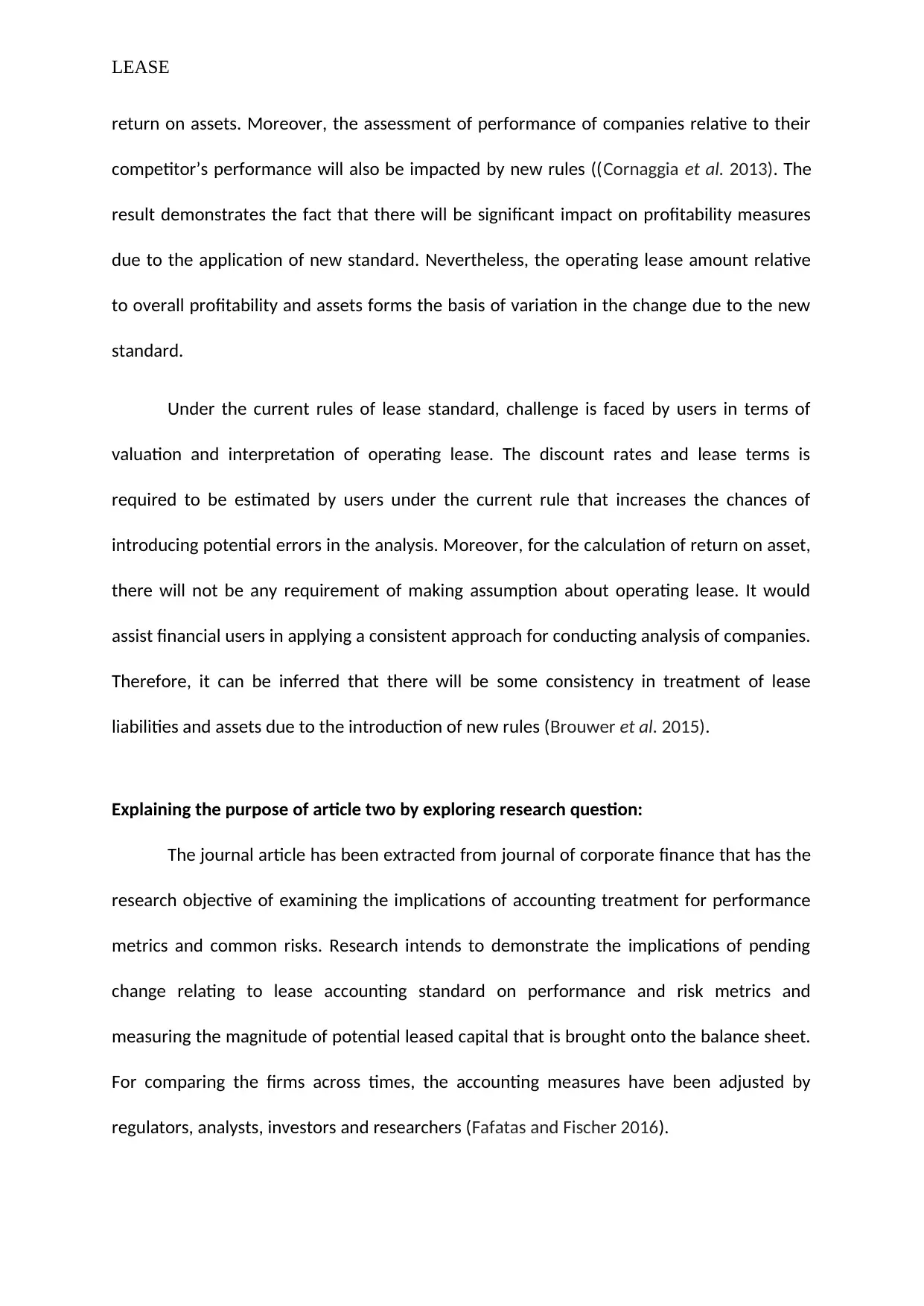
LEASE
return on assets. Moreover, the assessment of performance of companies relative to their
competitor’s performance will also be impacted by new rules ((Cornaggia et al. 2013). The
result demonstrates the fact that there will be significant impact on profitability measures
due to the application of new standard. Nevertheless, the operating lease amount relative
to overall profitability and assets forms the basis of variation in the change due to the new
standard.
Under the current rules of lease standard, challenge is faced by users in terms of
valuation and interpretation of operating lease. The discount rates and lease terms is
required to be estimated by users under the current rule that increases the chances of
introducing potential errors in the analysis. Moreover, for the calculation of return on asset,
there will not be any requirement of making assumption about operating lease. It would
assist financial users in applying a consistent approach for conducting analysis of companies.
Therefore, it can be inferred that there will be some consistency in treatment of lease
liabilities and assets due to the introduction of new rules (Brouwer et al. 2015).
Explaining the purpose of article two by exploring research question:
The journal article has been extracted from journal of corporate finance that has the
research objective of examining the implications of accounting treatment for performance
metrics and common risks. Research intends to demonstrate the implications of pending
change relating to lease accounting standard on performance and risk metrics and
measuring the magnitude of potential leased capital that is brought onto the balance sheet.
For comparing the firms across times, the accounting measures have been adjusted by
regulators, analysts, investors and researchers (Fafatas and Fischer 2016).
return on assets. Moreover, the assessment of performance of companies relative to their
competitor’s performance will also be impacted by new rules ((Cornaggia et al. 2013). The
result demonstrates the fact that there will be significant impact on profitability measures
due to the application of new standard. Nevertheless, the operating lease amount relative
to overall profitability and assets forms the basis of variation in the change due to the new
standard.
Under the current rules of lease standard, challenge is faced by users in terms of
valuation and interpretation of operating lease. The discount rates and lease terms is
required to be estimated by users under the current rule that increases the chances of
introducing potential errors in the analysis. Moreover, for the calculation of return on asset,
there will not be any requirement of making assumption about operating lease. It would
assist financial users in applying a consistent approach for conducting analysis of companies.
Therefore, it can be inferred that there will be some consistency in treatment of lease
liabilities and assets due to the introduction of new rules (Brouwer et al. 2015).
Explaining the purpose of article two by exploring research question:
The journal article has been extracted from journal of corporate finance that has the
research objective of examining the implications of accounting treatment for performance
metrics and common risks. Research intends to demonstrate the implications of pending
change relating to lease accounting standard on performance and risk metrics and
measuring the magnitude of potential leased capital that is brought onto the balance sheet.
For comparing the firms across times, the accounting measures have been adjusted by
regulators, analysts, investors and researchers (Fafatas and Fischer 2016).
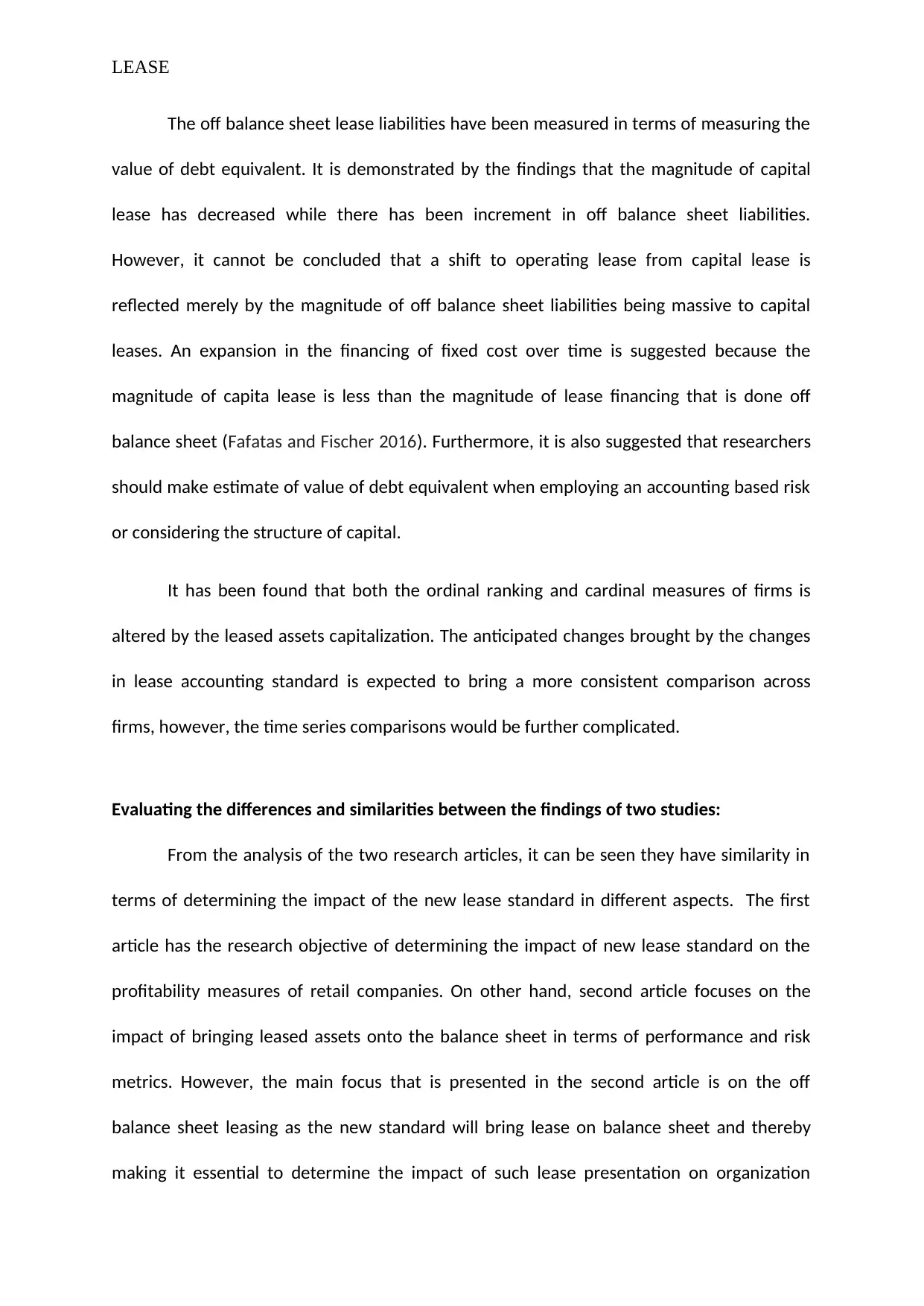
LEASE
The off balance sheet lease liabilities have been measured in terms of measuring the
value of debt equivalent. It is demonstrated by the findings that the magnitude of capital
lease has decreased while there has been increment in off balance sheet liabilities.
However, it cannot be concluded that a shift to operating lease from capital lease is
reflected merely by the magnitude of off balance sheet liabilities being massive to capital
leases. An expansion in the financing of fixed cost over time is suggested because the
magnitude of capita lease is less than the magnitude of lease financing that is done off
balance sheet (Fafatas and Fischer 2016). Furthermore, it is also suggested that researchers
should make estimate of value of debt equivalent when employing an accounting based risk
or considering the structure of capital.
It has been found that both the ordinal ranking and cardinal measures of firms is
altered by the leased assets capitalization. The anticipated changes brought by the changes
in lease accounting standard is expected to bring a more consistent comparison across
firms, however, the time series comparisons would be further complicated.
Evaluating the differences and similarities between the findings of two studies:
From the analysis of the two research articles, it can be seen they have similarity in
terms of determining the impact of the new lease standard in different aspects. The first
article has the research objective of determining the impact of new lease standard on the
profitability measures of retail companies. On other hand, second article focuses on the
impact of bringing leased assets onto the balance sheet in terms of performance and risk
metrics. However, the main focus that is presented in the second article is on the off
balance sheet leasing as the new standard will bring lease on balance sheet and thereby
making it essential to determine the impact of such lease presentation on organization
The off balance sheet lease liabilities have been measured in terms of measuring the
value of debt equivalent. It is demonstrated by the findings that the magnitude of capital
lease has decreased while there has been increment in off balance sheet liabilities.
However, it cannot be concluded that a shift to operating lease from capital lease is
reflected merely by the magnitude of off balance sheet liabilities being massive to capital
leases. An expansion in the financing of fixed cost over time is suggested because the
magnitude of capita lease is less than the magnitude of lease financing that is done off
balance sheet (Fafatas and Fischer 2016). Furthermore, it is also suggested that researchers
should make estimate of value of debt equivalent when employing an accounting based risk
or considering the structure of capital.
It has been found that both the ordinal ranking and cardinal measures of firms is
altered by the leased assets capitalization. The anticipated changes brought by the changes
in lease accounting standard is expected to bring a more consistent comparison across
firms, however, the time series comparisons would be further complicated.
Evaluating the differences and similarities between the findings of two studies:
From the analysis of the two research articles, it can be seen they have similarity in
terms of determining the impact of the new lease standard in different aspects. The first
article has the research objective of determining the impact of new lease standard on the
profitability measures of retail companies. On other hand, second article focuses on the
impact of bringing leased assets onto the balance sheet in terms of performance and risk
metrics. However, the main focus that is presented in the second article is on the off
balance sheet leasing as the new standard will bring lease on balance sheet and thereby
making it essential to determine the impact of such lease presentation on organization
Paraphrase This Document
Need a fresh take? Get an instant paraphrase of this document with our AI Paraphraser
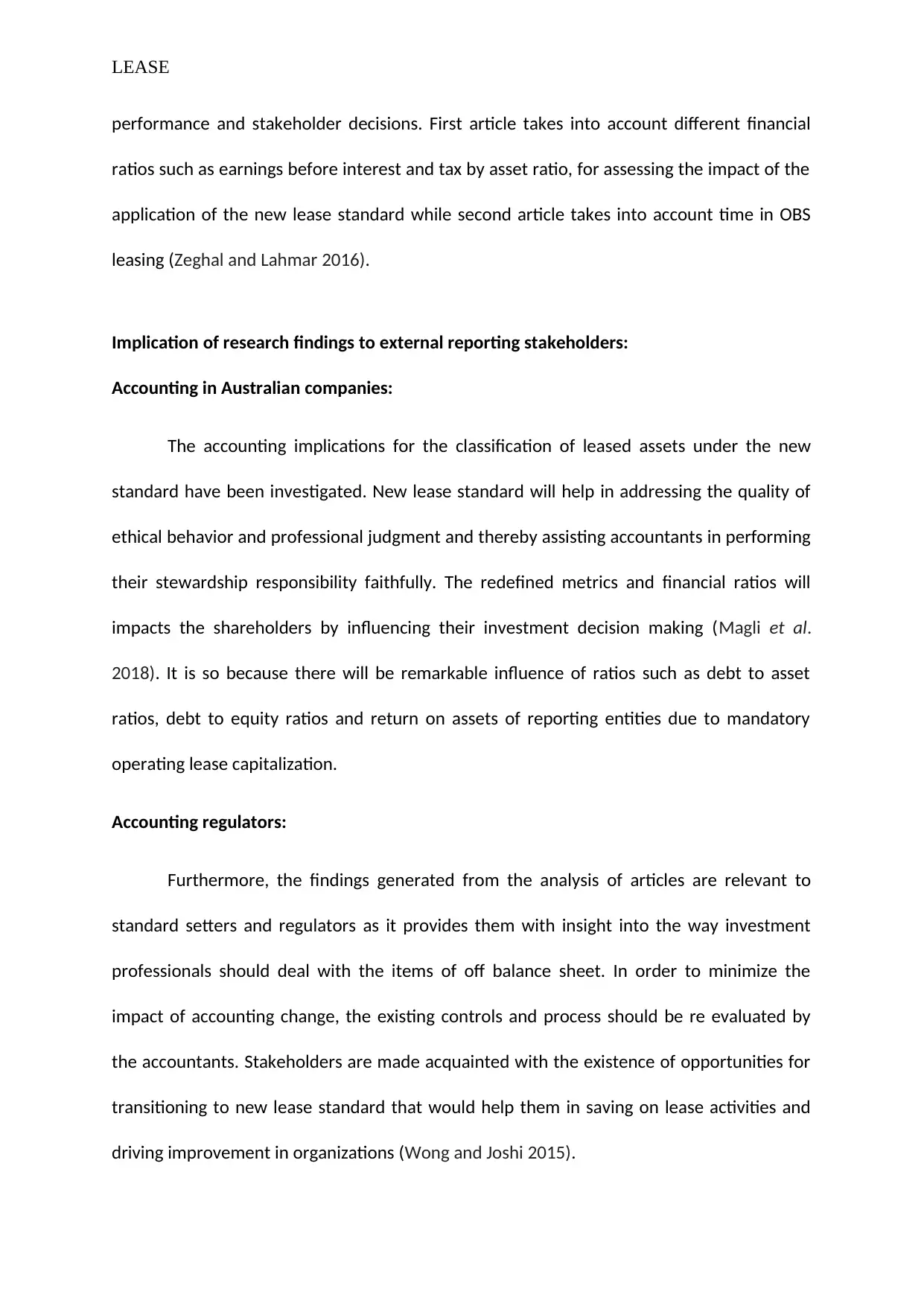
LEASE
performance and stakeholder decisions. First article takes into account different financial
ratios such as earnings before interest and tax by asset ratio, for assessing the impact of the
application of the new lease standard while second article takes into account time in OBS
leasing (Zeghal and Lahmar 2016).
Implication of research findings to external reporting stakeholders:
Accounting in Australian companies:
The accounting implications for the classification of leased assets under the new
standard have been investigated. New lease standard will help in addressing the quality of
ethical behavior and professional judgment and thereby assisting accountants in performing
their stewardship responsibility faithfully. The redefined metrics and financial ratios will
impacts the shareholders by influencing their investment decision making (Magli et al.
2018). It is so because there will be remarkable influence of ratios such as debt to asset
ratios, debt to equity ratios and return on assets of reporting entities due to mandatory
operating lease capitalization.
Accounting regulators:
Furthermore, the findings generated from the analysis of articles are relevant to
standard setters and regulators as it provides them with insight into the way investment
professionals should deal with the items of off balance sheet. In order to minimize the
impact of accounting change, the existing controls and process should be re evaluated by
the accountants. Stakeholders are made acquainted with the existence of opportunities for
transitioning to new lease standard that would help them in saving on lease activities and
driving improvement in organizations (Wong and Joshi 2015).
performance and stakeholder decisions. First article takes into account different financial
ratios such as earnings before interest and tax by asset ratio, for assessing the impact of the
application of the new lease standard while second article takes into account time in OBS
leasing (Zeghal and Lahmar 2016).
Implication of research findings to external reporting stakeholders:
Accounting in Australian companies:
The accounting implications for the classification of leased assets under the new
standard have been investigated. New lease standard will help in addressing the quality of
ethical behavior and professional judgment and thereby assisting accountants in performing
their stewardship responsibility faithfully. The redefined metrics and financial ratios will
impacts the shareholders by influencing their investment decision making (Magli et al.
2018). It is so because there will be remarkable influence of ratios such as debt to asset
ratios, debt to equity ratios and return on assets of reporting entities due to mandatory
operating lease capitalization.
Accounting regulators:
Furthermore, the findings generated from the analysis of articles are relevant to
standard setters and regulators as it provides them with insight into the way investment
professionals should deal with the items of off balance sheet. In order to minimize the
impact of accounting change, the existing controls and process should be re evaluated by
the accountants. Stakeholders are made acquainted with the existence of opportunities for
transitioning to new lease standard that would help them in saving on lease activities and
driving improvement in organizations (Wong and Joshi 2015).
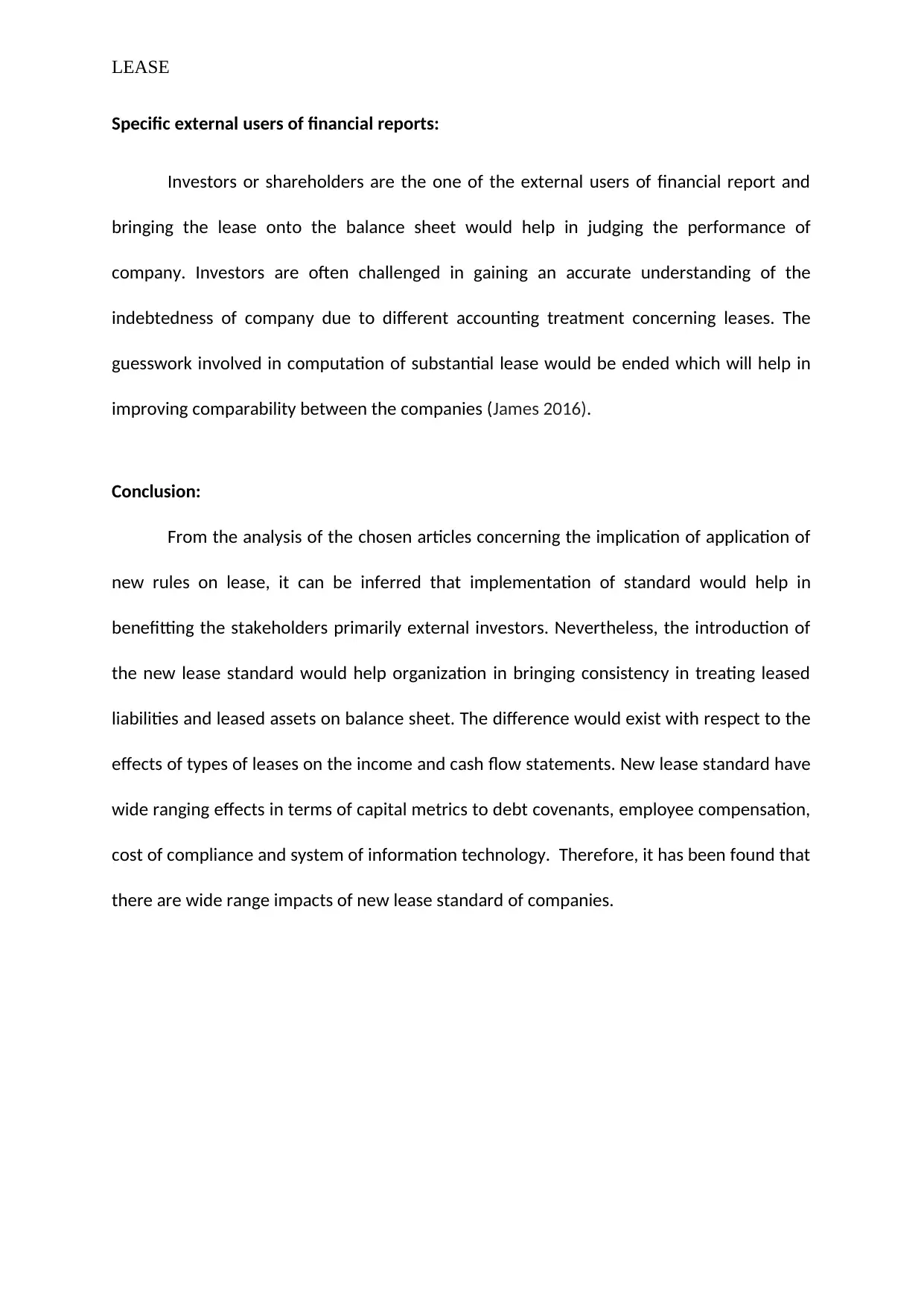
LEASE
Specific external users of financial reports:
Investors or shareholders are the one of the external users of financial report and
bringing the lease onto the balance sheet would help in judging the performance of
company. Investors are often challenged in gaining an accurate understanding of the
indebtedness of company due to different accounting treatment concerning leases. The
guesswork involved in computation of substantial lease would be ended which will help in
improving comparability between the companies (James 2016).
Conclusion:
From the analysis of the chosen articles concerning the implication of application of
new rules on lease, it can be inferred that implementation of standard would help in
benefitting the stakeholders primarily external investors. Nevertheless, the introduction of
the new lease standard would help organization in bringing consistency in treating leased
liabilities and leased assets on balance sheet. The difference would exist with respect to the
effects of types of leases on the income and cash flow statements. New lease standard have
wide ranging effects in terms of capital metrics to debt covenants, employee compensation,
cost of compliance and system of information technology. Therefore, it has been found that
there are wide range impacts of new lease standard of companies.
Specific external users of financial reports:
Investors or shareholders are the one of the external users of financial report and
bringing the lease onto the balance sheet would help in judging the performance of
company. Investors are often challenged in gaining an accurate understanding of the
indebtedness of company due to different accounting treatment concerning leases. The
guesswork involved in computation of substantial lease would be ended which will help in
improving comparability between the companies (James 2016).
Conclusion:
From the analysis of the chosen articles concerning the implication of application of
new rules on lease, it can be inferred that implementation of standard would help in
benefitting the stakeholders primarily external investors. Nevertheless, the introduction of
the new lease standard would help organization in bringing consistency in treating leased
liabilities and leased assets on balance sheet. The difference would exist with respect to the
effects of types of leases on the income and cash flow statements. New lease standard have
wide ranging effects in terms of capital metrics to debt covenants, employee compensation,
cost of compliance and system of information technology. Therefore, it has been found that
there are wide range impacts of new lease standard of companies.
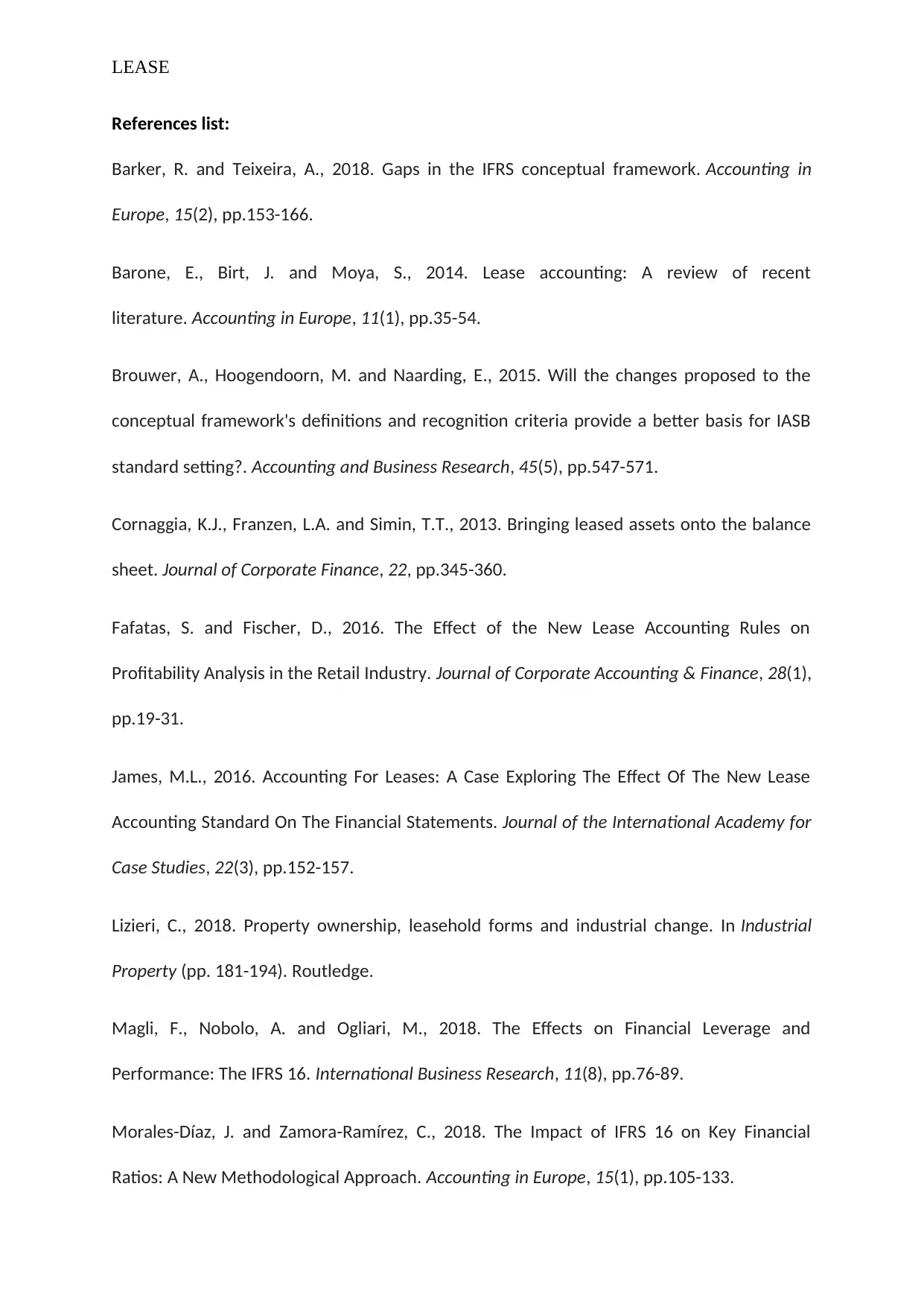
LEASE
References list:
Barker, R. and Teixeira, A., 2018. Gaps in the IFRS conceptual framework. Accounting in
Europe, 15(2), pp.153-166.
Barone, E., Birt, J. and Moya, S., 2014. Lease accounting: A review of recent
literature. Accounting in Europe, 11(1), pp.35-54.
Brouwer, A., Hoogendoorn, M. and Naarding, E., 2015. Will the changes proposed to the
conceptual framework's definitions and recognition criteria provide a better basis for IASB
standard setting?. Accounting and Business Research, 45(5), pp.547-571.
Cornaggia, K.J., Franzen, L.A. and Simin, T.T., 2013. Bringing leased assets onto the balance
sheet. Journal of Corporate Finance, 22, pp.345-360.
Fafatas, S. and Fischer, D., 2016. The Effect of the New Lease Accounting Rules on
Profitability Analysis in the Retail Industry. Journal of Corporate Accounting & Finance, 28(1),
pp.19-31.
James, M.L., 2016. Accounting For Leases: A Case Exploring The Effect Of The New Lease
Accounting Standard On The Financial Statements. Journal of the International Academy for
Case Studies, 22(3), pp.152-157.
Lizieri, C., 2018. Property ownership, leasehold forms and industrial change. In Industrial
Property (pp. 181-194). Routledge.
Magli, F., Nobolo, A. and Ogliari, M., 2018. The Effects on Financial Leverage and
Performance: The IFRS 16. International Business Research, 11(8), pp.76-89.
Morales-Díaz, J. and Zamora-Ramírez, C., 2018. The Impact of IFRS 16 on Key Financial
Ratios: A New Methodological Approach. Accounting in Europe, 15(1), pp.105-133.
References list:
Barker, R. and Teixeira, A., 2018. Gaps in the IFRS conceptual framework. Accounting in
Europe, 15(2), pp.153-166.
Barone, E., Birt, J. and Moya, S., 2014. Lease accounting: A review of recent
literature. Accounting in Europe, 11(1), pp.35-54.
Brouwer, A., Hoogendoorn, M. and Naarding, E., 2015. Will the changes proposed to the
conceptual framework's definitions and recognition criteria provide a better basis for IASB
standard setting?. Accounting and Business Research, 45(5), pp.547-571.
Cornaggia, K.J., Franzen, L.A. and Simin, T.T., 2013. Bringing leased assets onto the balance
sheet. Journal of Corporate Finance, 22, pp.345-360.
Fafatas, S. and Fischer, D., 2016. The Effect of the New Lease Accounting Rules on
Profitability Analysis in the Retail Industry. Journal of Corporate Accounting & Finance, 28(1),
pp.19-31.
James, M.L., 2016. Accounting For Leases: A Case Exploring The Effect Of The New Lease
Accounting Standard On The Financial Statements. Journal of the International Academy for
Case Studies, 22(3), pp.152-157.
Lizieri, C., 2018. Property ownership, leasehold forms and industrial change. In Industrial
Property (pp. 181-194). Routledge.
Magli, F., Nobolo, A. and Ogliari, M., 2018. The Effects on Financial Leverage and
Performance: The IFRS 16. International Business Research, 11(8), pp.76-89.
Morales-Díaz, J. and Zamora-Ramírez, C., 2018. The Impact of IFRS 16 on Key Financial
Ratios: A New Methodological Approach. Accounting in Europe, 15(1), pp.105-133.
Secure Best Marks with AI Grader
Need help grading? Try our AI Grader for instant feedback on your assignments.
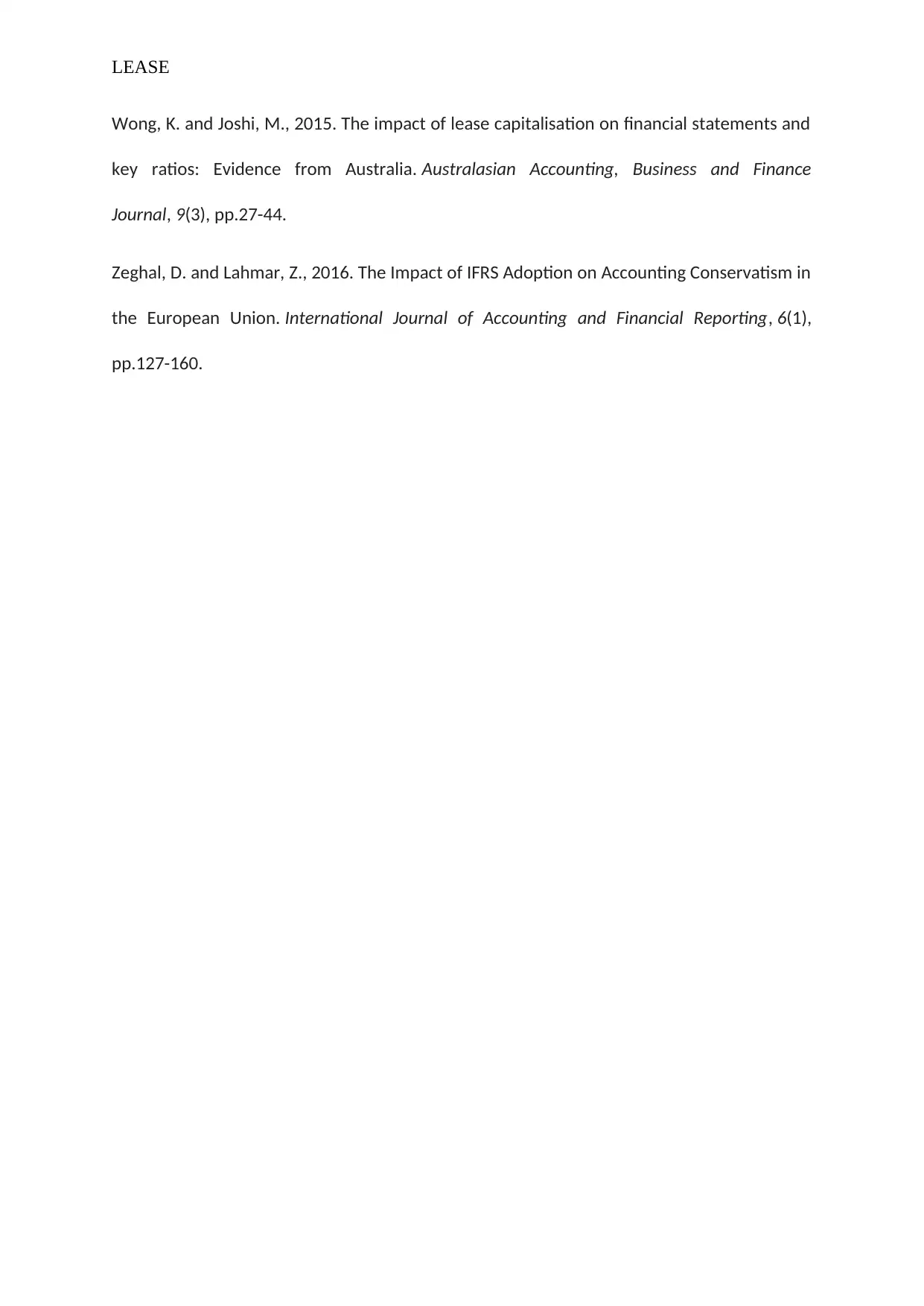
LEASE
Wong, K. and Joshi, M., 2015. The impact of lease capitalisation on financial statements and
key ratios: Evidence from Australia. Australasian Accounting, Business and Finance
Journal, 9(3), pp.27-44.
Zeghal, D. and Lahmar, Z., 2016. The Impact of IFRS Adoption on Accounting Conservatism in
the European Union. International Journal of Accounting and Financial Reporting, 6(1),
pp.127-160.
Wong, K. and Joshi, M., 2015. The impact of lease capitalisation on financial statements and
key ratios: Evidence from Australia. Australasian Accounting, Business and Finance
Journal, 9(3), pp.27-44.
Zeghal, D. and Lahmar, Z., 2016. The Impact of IFRS Adoption on Accounting Conservatism in
the European Union. International Journal of Accounting and Financial Reporting, 6(1),
pp.127-160.
1 out of 11
Related Documents
Your All-in-One AI-Powered Toolkit for Academic Success.
+13062052269
info@desklib.com
Available 24*7 on WhatsApp / Email
![[object Object]](/_next/static/media/star-bottom.7253800d.svg)
Unlock your academic potential
© 2024 | Zucol Services PVT LTD | All rights reserved.





